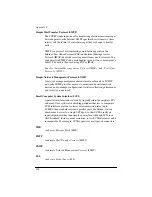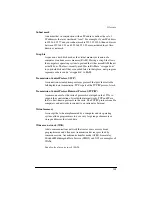
200
Packet
The unit of data that is routed between an origin and a destination on the
Internet or any other packet-switched network. The packet includes a
header containing control information and (usually) user data. Packets
are most often used to refer to network layer units of data.
PCI
see
Peripheral Component Interface (PCI)
Peripheral Component Interconnect (PCI)
Peripheral Component Interconnect (PCI) is an interconnection system
between a microprocessor and attached devices in which expansion
slots are spaced closely for high-speed operation. PCI is designed to be
synchronized with the clock speed of the microprocessor, in the range of
20 MHz to 33 Mhz.
PCI transmits 32 bits at a time in a 124-pin connection (the extra pins
are for power supply and grounding) and 64 bits in a 188-pin connection
in an expanded implementation. PCI uses all active paths to transmit
both address and data signals, sending the address on one clock cycle
and data on the next. Burst data can be sent starting with an address on
the first cycle and a sequence of data transmissions on a certain number
of successive cycles.
POP3
see
Post Office Protocol (POP3)
Post Office Protocol 3 (POP3)
Post Office Protocol (POP) is a standard protocol for receiving email.
POP is a client/server protocol in which email is received and held for
you by your Internet server. When you read your mail, all of it is
immediately downloaded to your computer and no longer maintained on
the server. POP3 is built into the Netscape Navigator and Microsoft
Internet Explorer browsers.
POP can be thought of as a store-and-forward service. Another protocol,
Internet Message Access Protocol (IMAP), can be thought of as a
remote file server.
Summary of Contents for Cobalt Qube 2
Page 1: ...Cobalt QubeTM 2 User Manual...
Page 6: ...vi...
Page 20: ...Chapter 1 6 Figure 3 Administrator Site screen Figure 4 Public Site screen...
Page 26: ...Chapter 1 12...
Page 68: ...Chapter 3 54...
Page 70: ...Chapter 4 56 Figure 17 Administrator Site screen...
Page 76: ...Chapter 4 62 Figure 19 shows the User Defaults table Figure 19 User Defaults table...
Page 78: ...Chapter 4 64 Figure 20 shows the Add New User table Figure 20 Add New User table...
Page 87: ...Administrator Site 73 Figure 24 shows the Add New Group table Figure 24 Add New Group table...
Page 184: ...Appendix B 170...
Page 206: ...Appendix E 192...
Page 218: ...Appendix F 204...





































